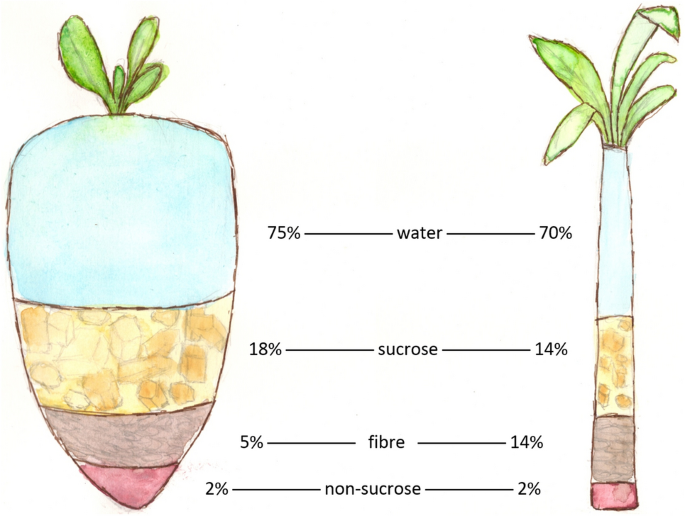Discovering the Distinctions in Usages and Benefits In Between Beet Sugar Vs Cane Sugar
In the cooking globe, the selection in between beet sugar and cane sugar is not just regarding sweetness however entails a nuanced consideration of taste, application, and impact. While both sugars originate from various plants, each goes through unique production procedures that subtly affect their attributes and suitability for different meals. As cooks and consumers significantly prioritize both the ecological and taste profiles of their ingredients, recognizing these distinctions becomes crucial. This exploration offers understanding right into just how each sugar kind can best boost cooking creations.
Beginnings and Manufacturing Procedures of Beet and Cane Sugar

Cane sugar, on the other hand, comes from the sugarcane plant, a tropical lawn indigenous to Southeast Asia yet now cultivated in tropical zones worldwide - beet sugar vs cane sugar. The production of cane sugar starts with the harvesting of cane stalks, which are crushed to release the juice.

Nutritional Content and Health And Wellness Considerations

When contrasting the dietary material of beet sugar and cane sugar, it ends up being obvious that both types essentially provide the same calorie worths, with around 16 calories per tsp and no considerable nutrient variety. Both sugars, when consumed in excess, can contribute to elevated blood glucose degrees, a threat aspect for diabetic issues and other metabolic disorders. From a wellness point of view, moderating consumption of any kind of type of sugar, whether from beet or cane, is recommended to avoid these potential adverse results on wellness.
Flavor Profiles and Culinary Applications
Regardless of their comparable chemical frameworks, beet sugar and cane sugar vary subtly in taste, which can affect their use in numerous culinary contexts. Walking cane sugar usually brings a hint of molasses, even in its polished type, offering a warm, caramel-like undertone that improves baked goods, Full Report coffee, and chocolate-based dishes. This slight molasses taste is especially valued in the cooking industry for including depth to sugary foods and pastries. On the other hand, beet sugar is identified by its highly fine-tuned, neutral taste, making it a flexible sugar that does not change the taste profiles of recipes. This neutrality is especially useful in fragile recipes, such as light pastries, lotions, and some sauces, where the fundamental tastes of other ingredients are meant to attract attention. As a result, cooks and food manufacturers may pick one sort of sugar over the other based upon the wanted flavor result of their culinary developments.
Ecological Influence and Sustainability
While both beet and cane sugars are obtained from plants, their environmental effects differ dramatically due to the unique approaches of farming and handling required for each. Sugar beet growing commonly includes extensive mechanization, which can raise find here fossil fuel intake and carbon exhausts.
In addition, the handling of sugarcane frequently generates a substantial amount of waste, consisting of bagasse, which, although usable as biofuel, regularly adds to air pollution if burned inefficiently. Sugar beet handling utilizes more of the raw materials, causing much less waste. Both industries encounter difficulties in decreasing their ecological footprints, but continuous technologies in farming methods and waste monitoring are aiming to boost sustainability.
Economic Elements Influencing the Sugar Market
The financial dynamics of the sugar market are substantially affected by worldwide market needs and trade plans. Elements such as tariffs, subsidies, and worldwide trade arrangements play critical roles in forming the competitive landscape. As an example, in areas where sugarcane or sugar beet manufacturing is subsidized, producers might have a monetary advantage that enables them to provide lower prices on the global market. This can create differences in profitability and market access for manufacturers in nations without such subsidies.
Additionally, variations in worldwide demand for sugar, affected by nutritional patterns and commercial usage in food, straight influence rates and production degrees. beet sugar vs cane sugar. Climate condition likewise play a crucial role, as they can significantly influence crop returns and, as a result, the supply chain. This variability presents a level of financial unpredictability that can result in financial investment volatility in sugar production industries, affecting decisions from planting to market approach
Final Thought
To conclude, both beet and cane sugar have special qualities that fit different culinary requirements. While cane sugar imparts a rich taste ideal for improving baked items, beet sugar's neutrality is ideal for lighter recipes. Nutritional similarities regardless of, their unique manufacturing procedures and more tips here ecological influences add intricacy to the selection in between them. Therefore, comprehending these distinctions aids chefs and customers make informed choices that line up with their health, culinary, and ethical choices.